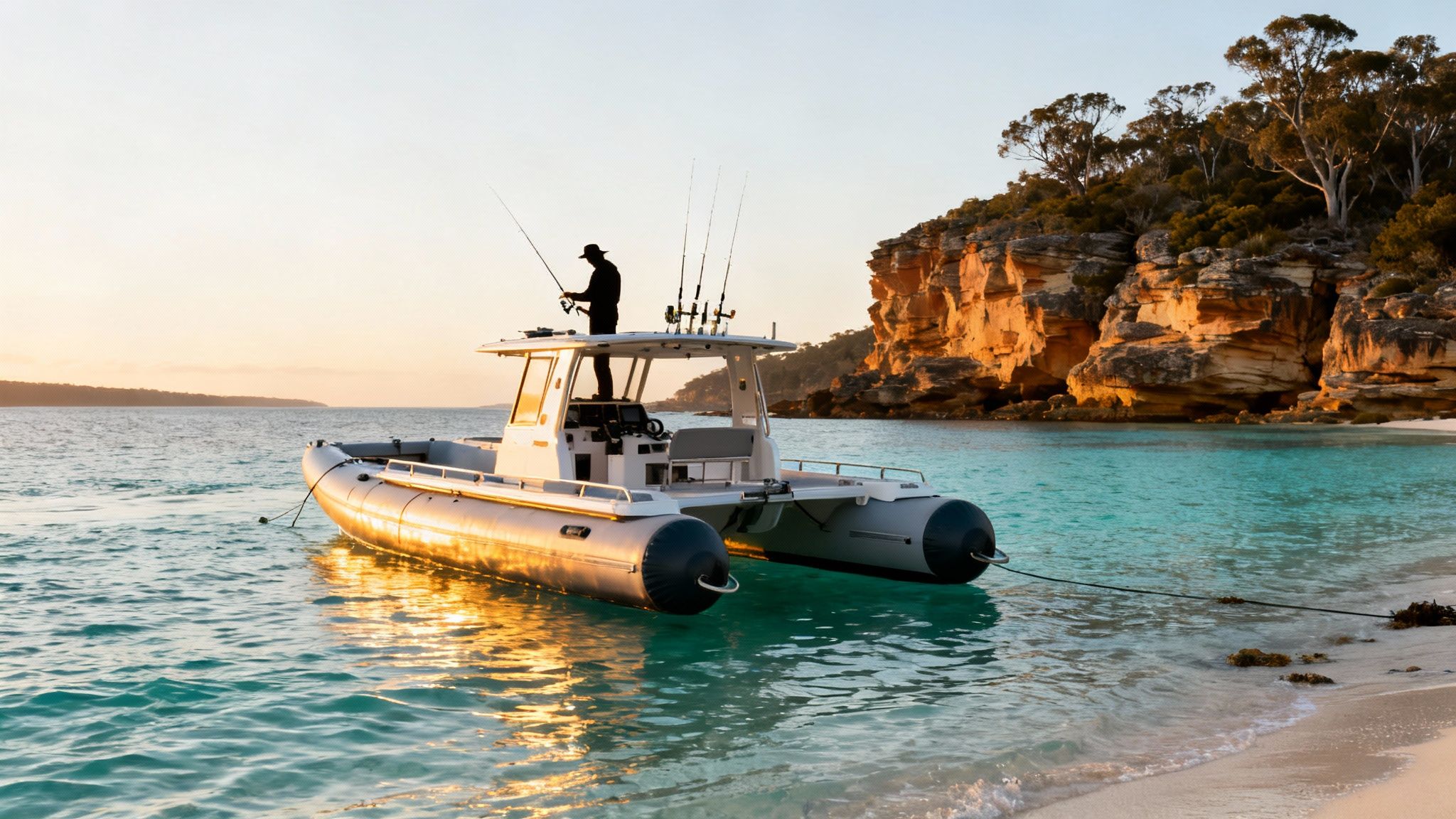
Finding an affordable outboard motor doesn't mean you have to settle for less on quality or reliability. For Aussie boaters, brands like Hidea Outboards have really nailed that sweet spot between performance and price, making it much easier to get out on the water without a huge upfront cost. The trick is to look past the sticker price and think about the total value you're getting, especially when pairing an engine with an inflatable boat for recreational use.
Choosing a new motor for your boat is a bit like buying a car; you don't need a high-performance V8 just for the daily school run. In the same way, you can find brilliant, dependable outboard motors that are a perfect match for your needs, whether you're just pottering around the estuaries or enjoying a family day out on the coast. This guide is here to cut through the noise and help you find a reliable workhorse that’ll give you years of good service.
The idea of "value" is what really matters here. It’s a simple balance of three things: the initial purchase price, the ongoing running costs, and how reliable it is in the long run. A low price tag is always tempting, but real affordability comes from an engine that's also good on fuel and doesn't need constant, expensive trips to the mechanic. For more on this, you might want to check out our guide on how to experience boat ownership without breaking the bank.
When you think about these factors together, it becomes much clearer what makes a motor a genuinely good deal. The infographic below breaks down how the initial cost, maintenance, and reliability all play a part in the total value of your motor.
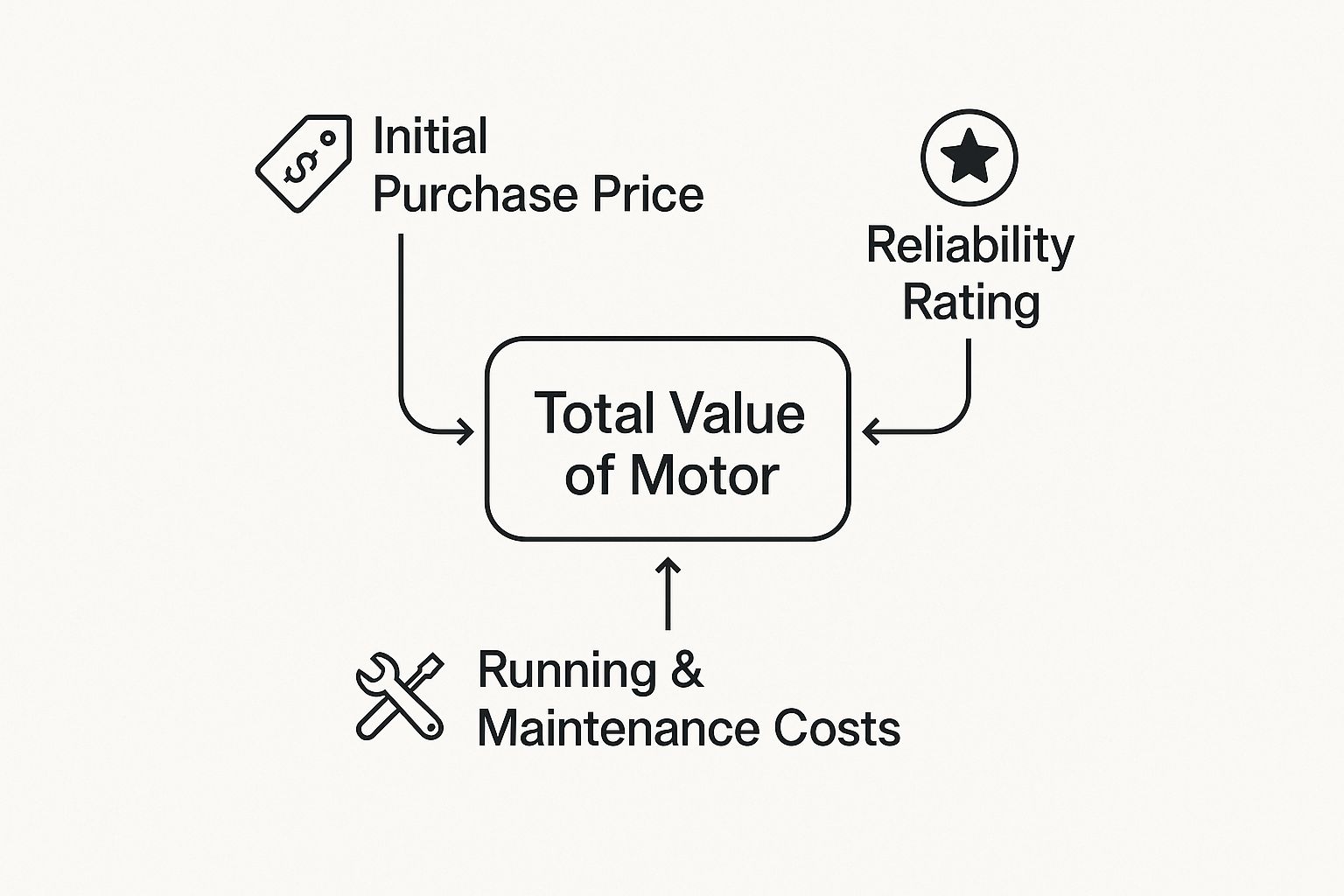
As you can see, a truly affordable outboard is one where all three elements are in balance—not just the one with the lowest price tag.
This balanced approach is especially important here in Australia, where boating is a massive part of our coastal lifestyle. Affordable outboards are the heart of this culture, with boat ownership hitting record levels recently. In fact, the national boating industry's turnover has surged to $10.12 billion, which just shows the huge demand for accessible marine power. This growth really highlights why brands that offer great value for money are so essential.
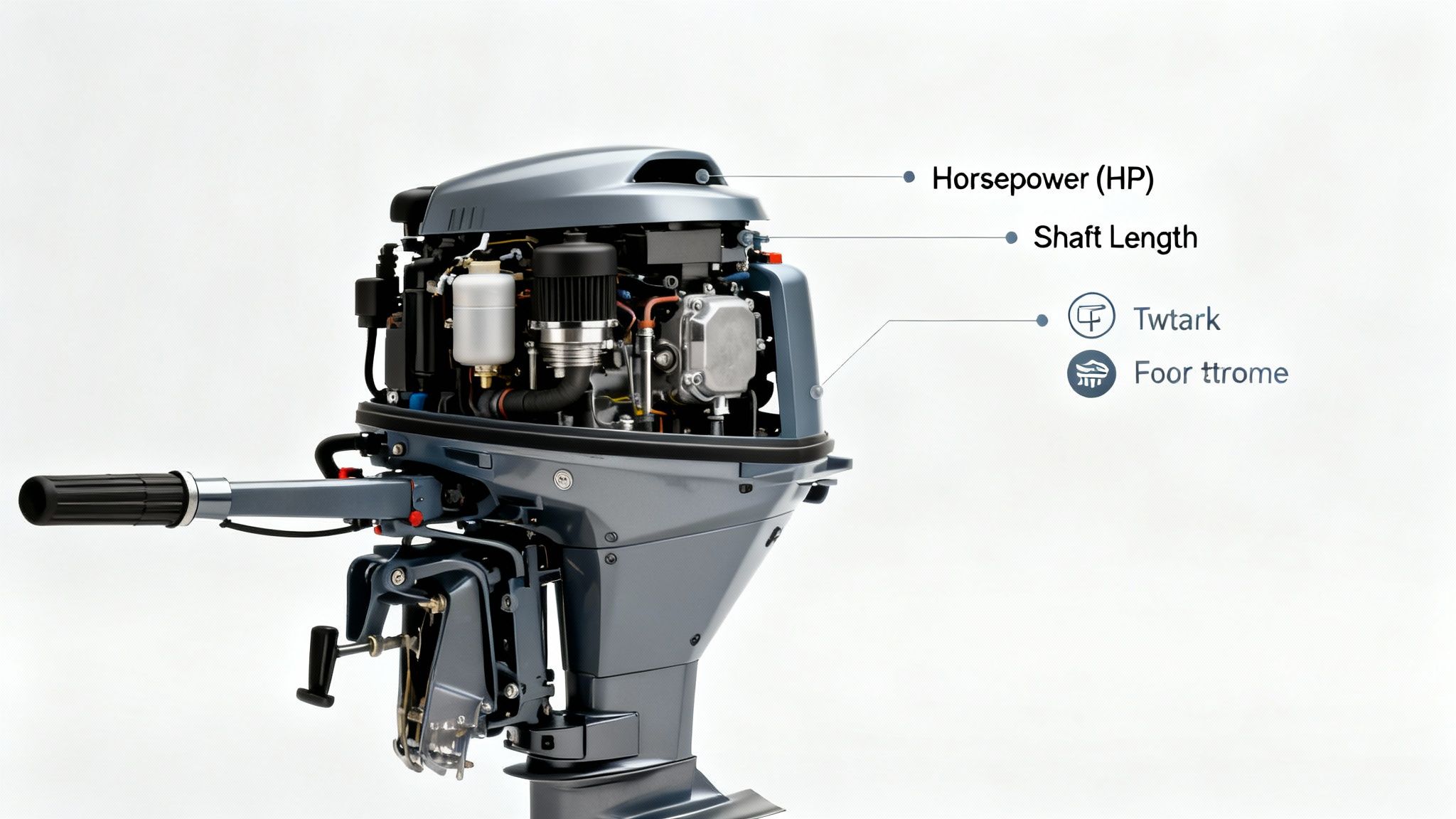
Choosing an affordable outboard motor can feel like trying to learn a new language. You'll hear terms like horsepower, shaft length, and stroke types thrown around, and it's easy to get lost in the jargon. But once you get the hang of it, you'll be able to pick the perfect engine for your boat with total confidence.
Think of it like matching the right tool to the right job—you wouldn’t use a sledgehammer to hang a picture frame, would you? The motor you need depends entirely on your boat and how you plan to use it. A small inflatable for quiet fishing trips in a calm estuary needs a completely different engine than a larger boat built for family outings on a coastal bay.
Getting these key specifications right is the first step to making a smart purchase.
Horsepower (HP) is the spec everyone knows. It's a simple measure of the motor's raw power, and a higher HP generally means more speed and a greater carrying capacity. But bigger isn't always better. Your boat has a maximum horsepower rating, which you can find on its compliance plate. You should never, ever exceed this limit for safety reasons.
Shaft length is just as crucial. This is the distance from the motor's mounting bracket down to the cavitation plate (that flat plate just above the propeller). It's vital to match this to your boat's transom height.
Getting the shaft length wrong will completely ruin your boat's performance. If it’s too short, the propeller will suck in air and lose grip. If it's too long, it creates a heap of unnecessary drag, slowing you down and wasting fuel.
The old two-stroke versus four-stroke debate is a classic in the boating world, and each has clear pros and cons, especially when you're looking for an affordable outboard. While petrol engines are still the most common choice, it's also worth checking out the growing market for clean, quiet electric power. If that piques your interest, our article on electric outboard motors in Australia is a great place to start.
To make the choice between petrol options a bit easier, this table breaks down the key differences.
| Feature | Two-Stroke Motor | Four-Stroke Motor |
|---|---|---|
| Simplicity & Weight | Fewer moving parts make it lighter and simpler to maintain. | More complex and heavier due to its car-like engine design. |
| Acceleration | Offers a much quicker, punchier "get up and go" from a stop. | Provides smoother and more consistent power delivery. |
| Fuel & Oil | You need to mix oil directly with the fuel before use. | Has separate oil and fuel systems, just like a car. |
| Noise & Emissions | Generally louder and produces more smoke and emissions. | Significantly quieter, cleaner, and more fuel-efficient. |
| Initial Cost | Often cheaper to buy upfront, a huge plus for budget motors. | Usually has a higher initial purchase price. |
Ultimately, choosing between a two-stroke and a four-stroke motor comes down to what you value most.
If you need a lightweight, powerful, and budget-friendly option for a small boat, a two-stroke is a fantastic contender. However, if better fuel economy, quieter operation, and a more environmentally friendly ride are more important to you, then a four-stroke is definitely the superior choice.
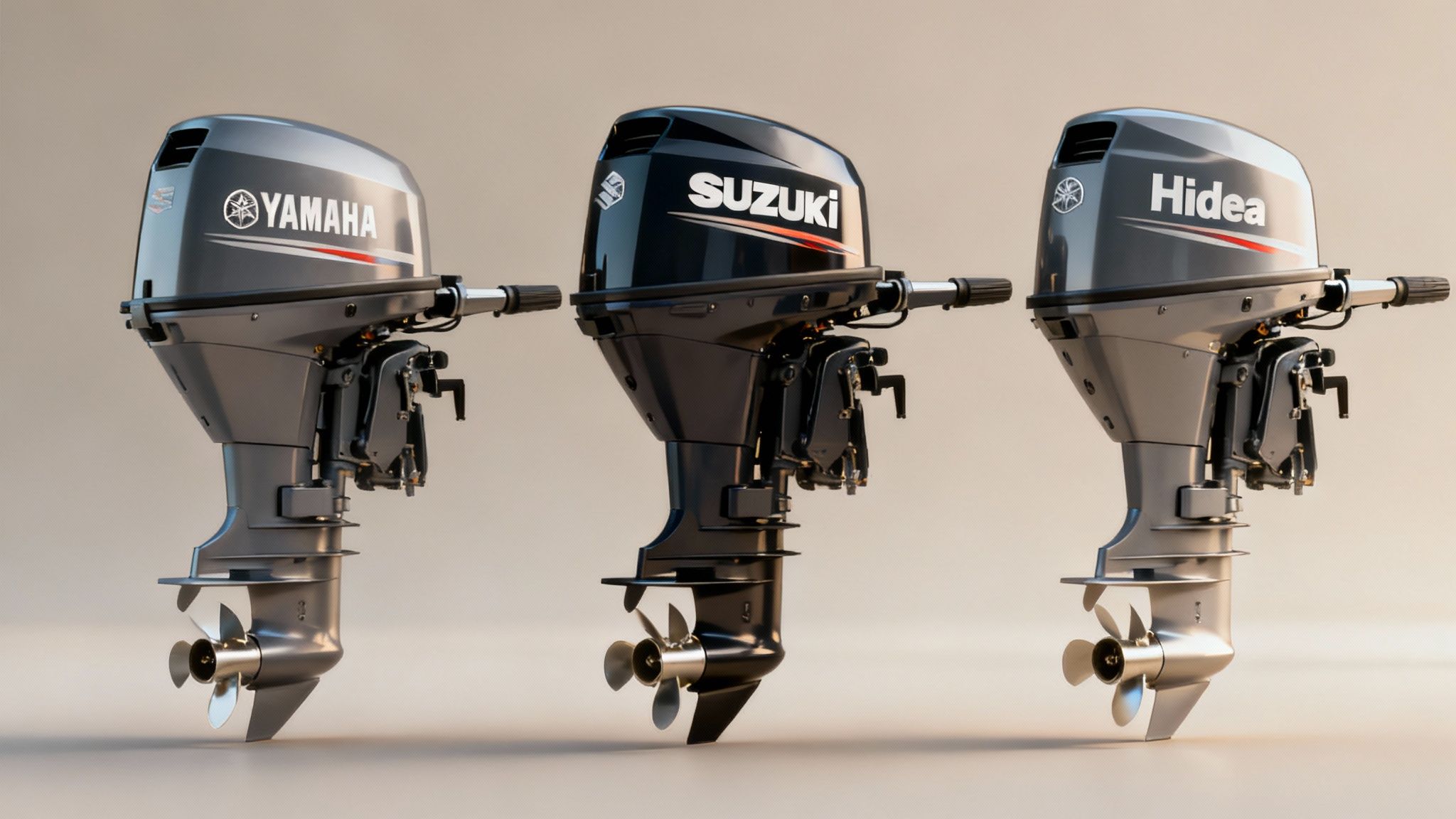
When you're looking to compare prices and features of inflatable boats and their motors in your area, you’ll quickly see a few key players dominate the conversation. It can feel a bit overwhelming at first, but several brands offer fantastic value without forcing you to compromise on reliability. Getting to know what each one brings to the table is the secret to finding the perfect motor for your inflatable boat.
For many Aussie boaters, the first port of call is usually established names like Yamaha and Suzuki. They’ve spent decades building bulletproof reputations for dependable engines, backed by huge dealer and service networks across the country. That widespread support offers real peace of mind, knowing that spare parts and a qualified mechanic are almost always just around the corner.
But the market for affordable outboard motors is much bigger than just the household names.
In recent years, a new wave of challenger brands has really shaken things up, offering modern, reliable motors at prices that are much easier to swallow. A prime example is Hidea Outboards, a brand that delivers impressive performance and features that go toe-to-toe with its more expensive rivals.
Hidea has smartly focused on building their engines around proven, time-tested designs. This approach cuts down on massive research and development costs while maximising reliability, allowing them to pass those savings directly on to you.
Brands like Hidea are a brilliant choice for first-time boat owners, families on a budget, or anyone who just wants to get out on the water without a massive financial hit. They prove you don’t need to spend a fortune to get a quality engine. If you want to dig a bit deeper, you can explore more about what makes Hidea outboards a great value-driven choice.
The global outboard market is pretty concentrated, with the top five brands holding a big slice of the pie. But that structure still leaves plenty of room for competition, which is fantastic news for buyers like us. Here in Australia, while the big brands like Yamaha are always popular, most buyers are really looking for reliability, easy maintenance, and a great upfront price—all areas where the affordable outboard segment shines. For more on these trends, you can find out more about global outboard industry insights on mordorintelligence.com.
Ultimately, choosing between an established name and a high-value challenger comes down to a trade-off. A premium brand might offer a slightly higher resale value down the track, but a brand like Hidea gives you a much lower entry cost with a full warranty. You get a brand-new, reliable engine for a fraction of the price.
Navigating the final steps of buying an outboard can feel a bit daunting. But arming yourself with the right questions turns a potentially stressful purchase into a confident one. This checklist is your practical roadmap, designed to make sure your new affordable outboard motor isn’t just a bargain, but a smart, long-term investment for your boat.
Think of it as your pre-flight check before you commit.
First things first, find your boat's compliance plate. This small but vital plate, usually found on the transom, spells out the maximum horsepower and weight your boat can safely handle. Never, ever exceed these limits. It’s a non-negotiable safety rule that keeps you and your passengers safe on the water.
With those numbers sorted, you can start assessing potential motors.
Whether you’re standing in a dealership or browsing online, having a clear set of questions will help you cut through the sales pitch and get to the information that actually matters. Any reputable seller will welcome your questions and provide straight answers.
Here are the key things you need to cover:
Once you’ve got your eye on a specific model, it’s time to get into the nitty-gritty. If you're buying in person, give the motor a proper look-over. Even on a brand-new engine, you want to check for any dings or scratches from transit.
Remember to account for the total cost of ownership, not just the sticker price. Hidden expenses can quickly turn an affordable motor into an unexpectedly costly one if you're not prepared.
It's also essential to ask about any extra costs involved in getting the motor fitted and ready for the water. These often-overlooked expenses can include:
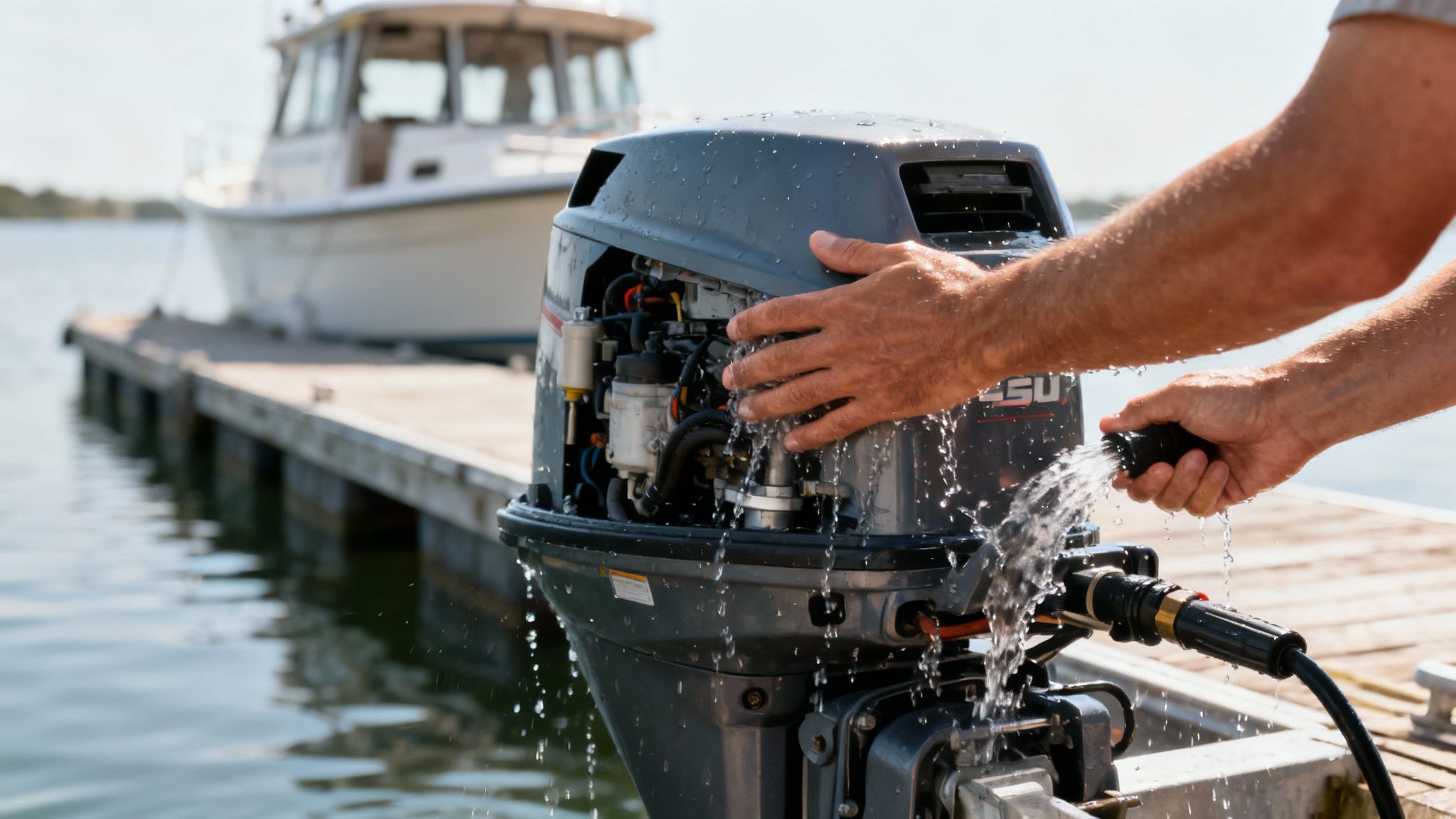
An affordable outboard motor is only a truly great deal if it stands the test of time. The real secret to getting years of reliable service from your engine isn't a high price tag; it's a commitment to simple, preventative maintenance.
A little bit of care goes a long way, saving you from expensive, trip-ruining repairs down the track. With just a few basic habits, you can ensure your affordable motor performs just as reliably as its pricier counterparts.
This is all about being proactive rather than reactive. By catching small issues before they become major headaches, you protect your investment and maximise your precious time on the water—which is right where you want to be.
Mastering a few straightforward tasks will form the bedrock of your engine care routine. These jobs don't require a mechanic's workshop, just a bit of diligence after each trip. Think of it as a quick post-adventure ritual that pays huge dividends in the long run.
Your essential checklist should include:
While your DIY checks are vital, they don't replace the need for professional servicing. Your motor's user manual contains a manufacturer-recommended service schedule—and you should stick to it religiously.
This schedule outlines critical tasks best left to a qualified mechanic, such as changing the gearbox oil, replacing the water pump impeller, and tuning the carburettor.
Following the official service schedule is crucial not only for the engine's health but also for keeping your warranty valid. Documented professional servicing proves you've properly cared for the motor, which is vital if you ever need to make a warranty claim.
Sticking to this routine ensures that an expert eye is regularly checking the internal components you can't see. This combination of diligent DIY care and periodic professional servicing is the ultimate strategy for making sure your affordable outboard motor gives you many seasons of hassle-free boating.
As you get closer to a decision, you might have questions like "What are the best inflatable boats for recreational use available near me?" or "Where can I hire an inflatable boat in Australia for a family outing?" Getting straight answers is the final step to buying your new outboard with complete confidence. This section tackles the most common queries we hear from Aussie boaters, cutting through the noise to give you the practical advice you need.
We’ll look at the classic dilemma of new versus used, figure out how much power you really need for your inflatable, and address whether today's value-focused brands can be trusted for the long haul.
This is a crossroads many buyers face, and the right choice usually comes down to your personal tolerance for risk and how comfortable you are with a spanner in your hand.
A new affordable motor, especially from a reputable brand like Hidea Outboards, comes with a full manufacturer's warranty. This is a massive advantage. It gives you total peace of mind and predictable costs right from day one. You know exactly what you're getting: a fresh, reliable engine ready to hit the water.
A used motor from a premium brand might seem like a bargain with its high-performance pedigree, but it’s always a gamble. It comes with an unknown history, potential hidden issues, and absolutely no warranty. Any initial savings can be wiped out fast by an unexpected repair bill.
For most people, particularly first-time boat owners or those who just want hassle-free boating, a new affordable motor is the smarter and safer investment.
The golden rule is simple: always check your boat's compliance plate first. This little plate tells you the maximum horsepower your vessel can safely handle. Going over that limit is not just dangerous, it's illegal.
For the vast majority of recreational inflatable boats, an engine somewhere between 5 HP and 25 HP is the sweet spot. To narrow it down, just think about what a typical day on the water looks like for you:
Matching the power to your actual needs means you won’t be wasting fuel or putting unnecessary strain on your boat. It's all about finding that perfect balance.
Yes, absolutely. Modern challenger brands like Hidea Outboards have made huge leaps in quality and now produce seriously reliable and durable motors. They keep prices down not by cutting corners, but by using proven, time-tested engine designs and manufacturing them efficiently at a massive scale.
The key to guaranteeing that reliability is buying from an authorised Australian dealer. A good dealer provides a solid local warranty, offers after-sales support, and ensures that spare parts and service expertise are always available. Customer reviews and on-water performance show time and again that today’s affordable outboards, especially trusted brands like Hidea, deliver outstanding value and dependability you can count on.
Ready to find the perfect power for your boat? Explore our complete range of Easy Inflatables boat packages and Hidea outboards to get a reliable, high-value setup that will have you on the water in no time. Check out the options at https://easyinflatables.com.au today.
Experience the ultimate freedom on the water with our top-quality inflatable boats and accessories. Easy Inflatables is your trusted partner, providing everything you need for a safe and unforgettable adventure.
At Easy Inflatables, we believe in empowering adventurers with high-quality inflatable solutions. Our commitment to durability and performance ensures that every product enhances your outdoor experiences.